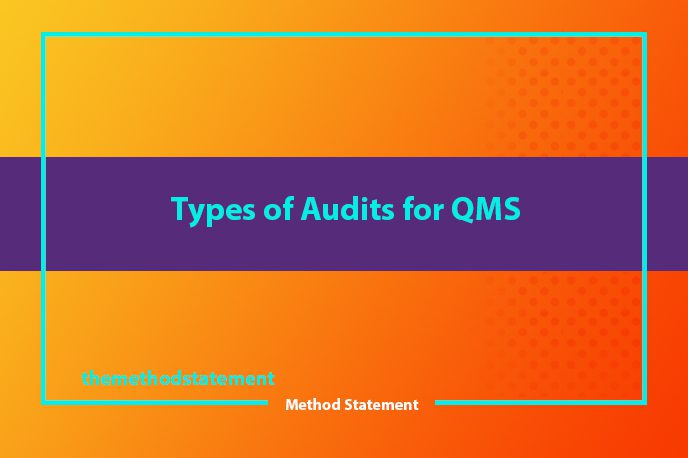Table of Contents
Types of Audits for QMS (System Product and Quality Compliance) are a crucial aspect of quality management. Conducting regular audits helps organizations to verify and ensure that they adhere to all mandatory requirements and legal and regulatory obligations.
The article explores various types of audits, including product or service quality audits, process audits, compliance audits, and more. By conducting these audits, organizations can identify areas for improvement and continuously deliver excellent quality products or services to their customers.
5 Types of Audits for QMS
A Quality Management System (QMS) audit is an essential tool to verify and ensure that a company adheres to all mandatory requirements. There are various types of audits that depend upon the purpose of the audit. In technical terms, there are several types of audits, including:
1. System Audit
Most organizations have various management or operational systems that, when put together, form a whole integrated management system. When management wants to make sure its systems are well-maintained, they decide to conduct internal audits. A system audit is an audit conducted on any of the systems in a company. Any non-conformity during a system audit is critical since if the system itself is incorrect, the output is likely to be wrong.
2. Product or Service Quality Audit
A product or service audit is conducted on the product or service itself to find out if it meets the requirements of the customers and the standards set by the organization. You can perform a product audit or a service audit at various phases of production or manufacturing. If there is any non-conformity during the quality assurance audit, this becomes quite serious since all the non-conformities at this juncture are equivalent to customer complaints.
3. Department/Functional Audit
The department audit is performed with a focus on a specified department or function. The scope of the audit comprises all the activities performed by a department, all the procedures followed, and all the systems available in the department. This form of audit highlights the areas for improvement in the specific department.
4. Process Audit
Processes are critical for the smooth functioning of an organization. All the activities from order inquiry to delivery of products follow a defined process in any organization. Therefore an audit of such processes enables organizations to identify the areas for improvement. Process audit also encompasses the audit of some special manufacturing processes that are critical for the quality of the end product.
5. Compliance Audit
A compliance audit is performed by regulatory agencies to confirm if the organization is fulfilling the legal and regulatory requirements. In case of any non-conformity, a re-audit may be required. The purpose of the re-audit is to ensure the effectiveness of the corrective actions performed.
The output of the audit is an audit report that is circulated to all the concerned individuals. The purpose of any form of QA audit is not to find mistakes but to find areas for improvement. If it is adopted by the auditor and the audited party in this spirit, the organization can be sure that it is on the path to improvement and will be able to consistently meet all customers, system, legal or regulatory requirements.
Key Takeaway
- Audits can be conducted by internal auditors or external parties such as certification audit agencies.
- The purpose of audits is not only to find mistakes but also to identify areas for improvement.
- Compliance audits are performed by regulatory agencies to ensure that organizations are complying with legal and regulatory requirements.
- Audit reports are the output of audits and are circulated to all concerned individuals.
- Process audits focus on identifying areas for improvement in the processes followed by an organization.
- Quality control audits highlight the need for improvements in the quality management system to consistently deliver excellent quality products or services.
- System audits are conducted to ensure that an organization’s management or operation systems are well-maintained and functioning properly.
- Product or service audits are performed to determine if a product or service meets the requirements of customers and standards set by the organization.
- Conformance audits are third-party audits conducted to evaluate if an organization fulfills the requirements as supposed by the systems.
| Type of Audit | Description |
|---|---|
| System Audit | An audit is performed by regulatory agencies to confirm if the organization is fulfilling legal and regulatory requirements |
| Product/Service Quality Audit | An audit is conducted on a product or service to ensure it meets customer requirements and organizational standards |
| Department Audit | Identify areas for improvement within a specific department or function |
| Process Audit | An audit is performed by regulatory agencies to confirm if the organization is fulfilling legal and regulatory requirements |
| Compliance Audit | An audit is performed by regulatory agencies to confirm if the organization is fulfilling legal and regulatory requirements |
Conclusion-Types of Audits for QMS (System Product and Quality Compliance)
Conducting various types of audits is critical for organizations to ensure that their quality management systems and products comply with regulatory and customer requirements. Each type of audit serves a unique purpose and can highlight areas for improvement in the organization.
By adopting a proactive approach towards quality assurance and consistently performing audits, companies can continuously improve their processes and deliver better products and services to their customers.
tag: # Types of Audits for QMS,
